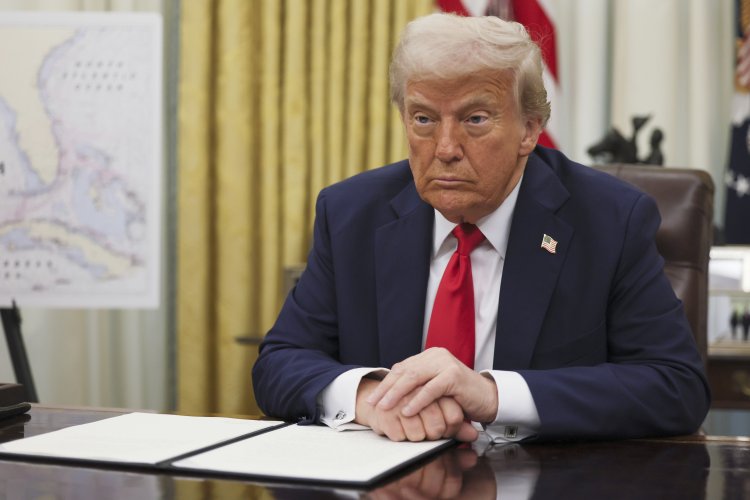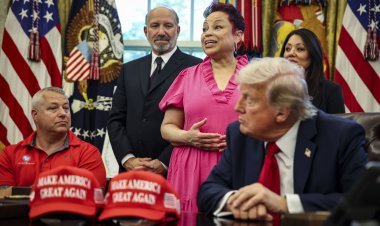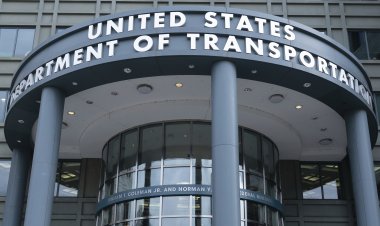Trump's "Liberation Day" Also Poses a Challenge for China
Wednesday's tariff announcement will provide insights into how the president approaches relations with the world's second-largest economy.

Wednesday's highly anticipated tariff announcement will test Trump's strategy in engaging with the world's second-largest economy and determining if he can bring the United States’ primary economic rival to the negotiation table.
Since Trump introduced a 10 percent across-the-board tariff on China in February, the White House has hinted at an imminent phone call with Chinese President Xi Jinping. However, Beijing has largely resisted engaging with the administration, even after the White House doubled its tariffs on China in March.
“Trump sort of sent the signal, ‘If you come to Washington, make nice and negotiate, maybe you’ll get some breaks.’ And so far Xi Jinping just hasn’t been willing to come over and negotiate,” commented Peter Harrell, who led the international economics team on President Joe Biden’s National Security Council.
China's reaction contrasts sharply with the discontent and anxiety felt by U.S. allies like Canada, Mexico, and the European Union, who have expressed panic and offense at their treatment from the new American government. In contrast, China has adopted a composed stance, indicating that it is not intimidated by Trump's threats. This is partly because China has become adept at circumventing U.S. tariffs.
The Chinese are “like really good tax cheats,” noted Derek Scissors, a senior fellow at the American Enterprise Institute who specializes in U.S.-China relations. “If there's a hole, the tax cheats will find it and pay less taxes. That’s what China is like on tariffs. Other countries can’t do that as well.”
The “reciprocal tariffs” that Trump plans to announce on Wednesday might help close some of these loopholes by imposing high duties on countries through which China ships its products, effectively using nations with lower tariffs, such as Vietnam, Taiwan, and Mexico, to process its goods. This escalation of the trade conflict with Beijing could have significant implications for the global economy.
Despite pressure from China hawks in Congress, it's uncertain how far Trump and his administration are willing to go to curtail Chinese trade, as they seek to avoid alarming financial markets while also aiming to entice Xi to the negotiation table.
For weeks, Trump has highlighted his April 2 “Liberation Day” tariff announcement as a means to confront countries with substantial trade surpluses with the U.S. and substantial barriers to American goods. “They’re reciprocal, so whatever they charge us, we’ll charge them,” Trump stated to reporters on Monday. “But we’re being nicer than they are.”
Economic adviser Kevin Hassett mentioned in a Fox News interview last month that the administration is considering 10 to 15 countries that contribute to the U.S.'s “entire trillion-dollar trade deficit.”
China represents the largest part of that deficit, according to Commerce Department data for 2024. However, that deficit has decreased since 2018, when Trump implemented tariffs on about $300 billion in Chinese goods. Meanwhile, U.S. imports from Mexico and Vietnam have surged as Chinese companies increasingly routed goods through those countries.
The U.S. Trade Representative's office identified Mexico, Vietnam, and Taiwan, among other nations, in February when it sought stakeholder comments for a review of unfair trade practices mandated by Trump. The findings from that review are due for release today and are expected to influence the formulation of reciprocal tariffs.
White House press secretary Karoline Leavitt teased the upcoming announcement on Tuesday but provided no specifics regarding the tariffs' mechanics or rates.
“The president said last night that he has made a decision and a determination,” Leavitt informed reporters during a press briefing. “He is with his trade and tariff team right now perfecting it to make sure this is a perfect deal for the American people and the American worker, and you will all find out in about 24 hours from now.”
Depending on their size and reach, additional tariffs on Mexico, Vietnam, and Taiwan could represent Trump’s most substantial blow to Chinese manufacturing yet. This could, in turn, substantially increase consumer goods prices, such as electronics, Harrell warns.
“There will be a couple of particular product categories where in the short run, Americans will see higher costs, and in the longer run, you’ll probably see further diversification away from markets subject to the higher reciprocal tariffs,” he added.
Such measures might also elicit a stronger response from Beijing, which has shown growing frustration with U.S. actions in recent days. Chinese Foreign Minister Wang Yi traveled to Russia this week to discuss U.S. policies, and state media reported that the Chinese government is contemplating coordinating a tariff response with Japan and South Korea—its traditional competitors.
Yet Trump has sent mixed signals, recently suggesting a potential deal to reduce tariffs on China if the country moves forward with a sale of TikTok, the Chinese-based social media app. Unlike his tough approach towards Canada and the European Union, he has expressed a positive outlook on Xi and hopes for future talks, raising speculation that Trump may be softening his position in pursuit of a "grand bargain" addressing both U.S.-China trade issues and geopolitical tensions, including those in the Taiwan Strait.
“No one should be surprised if we end up negotiating, trying to negotiate with China, and not really negotiating with the EU, for example,” Scissors remarked. “Because the Chinese can deliver stuff that Trump wants, and the EU won't or can't.”
“I’m not saying it’s going to work,” he added, “and I don’t think Trump is sure it’s going to work, either.”
Indeed, the U.S. learned during Trump’s first term that there’s no certainty that China will honor its commitments. China pledged to purchase an additional $200 billion in U.S. goods beyond 2017 levels under a 2020 agreement, but trade data shows it did not fulfill that promise, although it did comply with other commitments like removing technical barriers to U.S. farm exports and opening its financial services sector.
Furthermore, bipartisan pressure is mounting on the administration to concentrate its trade efforts more on Beijing instead of friendly nations like Canada.
“Imposing broad tariffs on China, which really has hurt us in trade every step of the way makes sense,” said Senate Minority Leader Chuck Schumer at a Tuesday press conference. “But to do that to Canada, our friend, whose interrelated economies depend on each other, makes no sense whatsoever.”
The chair and ranking member of the House Select Committee on the Chinese Communist Party sent a letter to various Trump officials earlier this month urging an investigation into China's attempts to evade tariffs through shipping.
Sen. Eric Schmitt expressed his support for Trump’s actions against American allies like Canada, viewing them as a method to reduce trade barriers, but emphasized that addressing China is critical for national security.
“I think we need to make it clear that they’re our chief adversary,” Schmitt stated. “I think engaging in discussions, no matter who it is, is always a good thing. But we need to make sure we have a real deterrent with China.”
Anna Muller for TROIB News
Find more stories on Business, Economy and Finance in TROIB business











